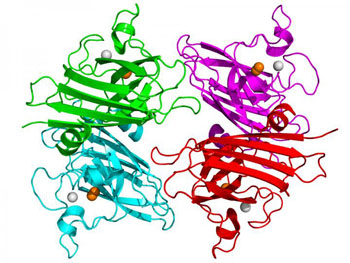Novel Copper Therapy Cures ALS Mouse Model
|
By LabMedica International staff writers Posted on 09 Feb 2016 |

Image: Copper, zinc superoxide dismutase (Cu Zn SOD) is essential to life, but when damaged can become toxic (Photo courtesy of Oregon State University).
Selective delivery of copper (Cu) to the central nervous system effectively treats the motor neuron disease amyotrophic lateral sclerosis (ALS) in the most widely used mouse model of the disorder.
ALS is a progressive and fatal neurodegenerative disease caused by the death and deterioration of motor neurons in the spinal cord that is linked to mutations in the enzyme copper, zinc superoxide dismutase (Cu, Zn SOD). Copper helps to stabilize the three-dimensional structure of this antioxidant enzyme, but when it lacks metal co-factors, SOD can unfold and become toxic, leading to the death of motor neurons.
Over-expression of mutant Cu, Zn SOD in mice induces ALS and has become the most widely used model of neurodegeneration. However, no pharmaceutical agent in 20 years has extended lifespan of these animals by more than a few weeks.
The Copper-Chaperone-for-SOD (CCS) protein completes the maturation of SOD by inserting copper, but paradoxically mice that have been genetically engineered to express human CCS while co-expressing mutant SOD die within two weeks of birth.
Hypothesizing that co-expression of CCS created copper deficiency in the spinal cord, investigators at Oregon State University (Corvallis, USA) treated these baby mice with the PET (positron emission tomography)-imaging agent CuATSM (diacetyl-bis(N4-methylthiosemicarbazone)), which is known to deliver copper into the central nervous system within minutes.
The investigators reported in the January 27, 2016, online edition of the journal Neurobiology of Disease that CuATSM prevented the early mortality of the CCSxSOD mice, while markedly increasing the level of Cu, Zn SOD protein in their ventral spinal cords. Remarkably, continued treatment with CuATSM extended the survival of these mice by an average of 18 months. When CuATSM treatment was stopped, these mice developed ALS-related symptoms and died within three months. Restoring CuATSM treatment could rescue these mice after they became symptomatic, providing a means to start and stop disease progression.
All human ALS patients express CCS, raising the hope that familial ALS patients could respond to CuATSM treatment similarly to the CCSxSOD mice.
"We are shocked at how well this treatment can stop the progression of ALS," said senior author Dr. Joseph Beckman, professor of biochemistry and at Oregon State University. "We have a solid understanding of why the treatment works in the mice, and we predict it should work in both familial and possibly sporadic human patients, but we will not know until we try. We want people to understand that we are moving to human trials as quickly as we can. In humans who develop ALS, the average time from onset to death is only three to four years."
Related Links:
Oregon State University
ALS is a progressive and fatal neurodegenerative disease caused by the death and deterioration of motor neurons in the spinal cord that is linked to mutations in the enzyme copper, zinc superoxide dismutase (Cu, Zn SOD). Copper helps to stabilize the three-dimensional structure of this antioxidant enzyme, but when it lacks metal co-factors, SOD can unfold and become toxic, leading to the death of motor neurons.
Over-expression of mutant Cu, Zn SOD in mice induces ALS and has become the most widely used model of neurodegeneration. However, no pharmaceutical agent in 20 years has extended lifespan of these animals by more than a few weeks.
The Copper-Chaperone-for-SOD (CCS) protein completes the maturation of SOD by inserting copper, but paradoxically mice that have been genetically engineered to express human CCS while co-expressing mutant SOD die within two weeks of birth.
Hypothesizing that co-expression of CCS created copper deficiency in the spinal cord, investigators at Oregon State University (Corvallis, USA) treated these baby mice with the PET (positron emission tomography)-imaging agent CuATSM (diacetyl-bis(N4-methylthiosemicarbazone)), which is known to deliver copper into the central nervous system within minutes.
The investigators reported in the January 27, 2016, online edition of the journal Neurobiology of Disease that CuATSM prevented the early mortality of the CCSxSOD mice, while markedly increasing the level of Cu, Zn SOD protein in their ventral spinal cords. Remarkably, continued treatment with CuATSM extended the survival of these mice by an average of 18 months. When CuATSM treatment was stopped, these mice developed ALS-related symptoms and died within three months. Restoring CuATSM treatment could rescue these mice after they became symptomatic, providing a means to start and stop disease progression.
All human ALS patients express CCS, raising the hope that familial ALS patients could respond to CuATSM treatment similarly to the CCSxSOD mice.
"We are shocked at how well this treatment can stop the progression of ALS," said senior author Dr. Joseph Beckman, professor of biochemistry and at Oregon State University. "We have a solid understanding of why the treatment works in the mice, and we predict it should work in both familial and possibly sporadic human patients, but we will not know until we try. We want people to understand that we are moving to human trials as quickly as we can. In humans who develop ALS, the average time from onset to death is only three to four years."
Related Links:
Oregon State University
Latest BioResearch News
- Genome Analysis Predicts Likelihood of Neurodisability in Oxygen-Deprived Newborns
- Gene Panel Predicts Disease Progession for Patients with B-cell Lymphoma
- New Method Simplifies Preparation of Tumor Genomic DNA Libraries
- New Tool Developed for Diagnosis of Chronic HBV Infection
- Panel of Genetic Loci Accurately Predicts Risk of Developing Gout
- Disrupted TGFB Signaling Linked to Increased Cancer-Related Bacteria
- Gene Fusion Protein Proposed as Prostate Cancer Biomarker
- NIV Test to Diagnose and Monitor Vascular Complications in Diabetes
- Semen Exosome MicroRNA Proves Biomarker for Prostate Cancer
- Genetic Loci Link Plasma Lipid Levels to CVD Risk
- Newly Identified Gene Network Aids in Early Diagnosis of Autism Spectrum Disorder
- Link Confirmed between Living in Poverty and Developing Diseases
- Genomic Study Identifies Kidney Disease Loci in Type I Diabetes Patients
- Liquid Biopsy More Effective for Analyzing Tumor Drug Resistance Mutations
- New Liquid Biopsy Assay Reveals Host-Pathogen Interactions
- Method Developed for Enriching Trophoblast Population in Samples
Channels
Clinical Chemistry
view channel
VOCs Show Promise for Early Multi-Cancer Detection
Early cancer detection is critical to improving survival rates, but most current screening methods focus on individual cancer types and often involve invasive procedures. This makes it difficult to identify... Read more
Portable Raman Spectroscopy Offers Cost-Effective Kidney Disease Diagnosis at POC
Kidney disease is typically diagnosed through blood or urine tests, often when patients present with symptoms such as blood in urine, shortness of breath, or weight loss. While these tests are common,... Read moreMolecular Diagnostics
view channel
Fast Low-Cost Alzheimer’s Tests Could Detect Disease in Early and Silent Stages
Early diagnosis remains one of the greatest challenges in combating Alzheimer’s disease, the most common cause of age-related dementia. With symptoms like memory loss and confusion typically appearing... Read more
Further Investigation of FISH-Negative Tests for Renal Cell Carcinoma Improves Diagnostic Accuracy
Accurate diagnosis of renal cell carcinoma (RCC) is critical to determining the right therapy, but standard diagnostic methods can sometimes miss important genetic alterations. Now, researchers have discovered... Read more
First Direct Measurement of Dementia-Linked Proteins to Enable Early Alzheimer’s Detection
The disease process in Alzheimer’s begins long before memory loss or cognitive decline becomes apparent. During this silent phase, misfolded proteins gradually form amyloid fibrils, which accumulate in... Read moreHematology
view channel
ADLM’s New Coagulation Testing Guidance to Improve Care for Patients on Blood Thinners
Direct oral anticoagulants (DOACs) are one of the most common types of blood thinners. Patients take them to prevent a host of complications that could arise from blood clotting, including stroke, deep... Read more
Viscoelastic Testing Could Improve Treatment of Maternal Hemorrhage
Postpartum hemorrhage, severe bleeding after childbirth, remains one of the leading causes of maternal mortality worldwide, yet many of these deaths are preventable. Standard care can be hindered by delays... Read more
Pioneering Model Measures Radiation Exposure in Blood for Precise Cancer Treatments
Scientists have long focused on protecting organs near tumors during radiotherapy, but blood — a vital, circulating tissue — has largely been excluded from dose calculations. Each blood cell passing through... Read moreImmunology
view channel
Chip Captures Cancer Cells from Blood to Help Select Right Breast Cancer Treatment
Ductal carcinoma in situ (DCIS) accounts for about a quarter of all breast cancer cases and generally carries a good prognosis. This non-invasive form of the disease may or may not become life-threatening.... Read more
Blood-Based Liquid Biopsy Model Analyzes Immunotherapy Effectiveness
Immunotherapy has revolutionized cancer care by harnessing the immune system to fight tumors, yet predicting who will benefit remains a major challenge. Many patients undergo costly and taxing treatment... Read moreMicrobiology
view channel
High-Throughput Enteric Panels Detect Multiple GI Bacterial Infections from Single Stool Swab Sample
Gastrointestinal (GI) infections are among the most common causes of illness worldwide, leading to over 1.7 million deaths annually and placing a heavy burden on healthcare systems. Conventional diagnostic... Read more
Fast Noninvasive Bedside Test Uses Sugar Fingerprint to Detect Fungal Infections
Candida bloodstream infections are a growing global health threat, causing an estimated 6 million cases and 3.8 million deaths annually. Hospitals are particularly vulnerable, as weakened patients after... Read morePathology
view channel
3D Genome Mapping Tool to Improve Diagnosis and Treatment of Genetic Diseases
Standard laboratory tests often fail to detect complex DNA rearrangements that underlie many genetic diseases. To bridge this diagnostic gap, researchers have developed a 3D chromosome mapping method that... Read more
New Molecular Analysis Tool to Improve Disease Diagnosis
Accurately distinguishing between similar biomolecules such as proteins is vital for biomedical research and diagnostics, yet existing analytical tools often fail to detect subtle structural or compositional... Read more
Tears Offer Noninvasive Alternative for Diagnosing Neurodegenerative Diseases
Diagnosing and monitoring eye and neurodegenerative diseases often requires invasive procedures to access ocular fluids. Ocular fluids like aqueous humor and vitreous humor contain valuable molecular information... Read moreTechnology
view channel
Portable Biosensor Diagnoses Psychiatric Disorders Using Saliva Samples
Early diagnosis of psychiatric disorders such as depression, schizophrenia, and bipolar disorder remains one of medicine’s most pressing challenges. Current diagnostic methods rely heavily on clinical... Read more
Cell-Sorting Device Uses Electromagnetic Levitation to Precisely Direct Cell Movement
Sorting different cell types—such as cancerous versus healthy or live versus dead cells—is a critical task in biology and medicine. However, conventional methods often require labeling, chemical exposure,... Read moreIndustry
view channel
Qiagen Acquires Single-Cell Omics Firm Parse Biosciences
QIAGEN (Venlo, Netherlands) has entered into a definitive agreement to fully acquire Parse Biosciences (Seattle, WA, USA), a provider of scalable, instrument-free solutions for single-cell research.... Read more
Puritan Medical Products Showcasing Innovation at AMP2025 in Boston
Puritan Medical Products (Guilford, ME, USA), the world’s most trusted manufacturer of swabs and specimen collection devices, is set to exhibit at AMP2025 in Boston, Massachusetts, from November 11–15.... Read more
Advanced Instruments Merged Under Nova Biomedical Name
Advanced Instruments (Norwood, MA, USA) and Nova Biomedical (Waltham, MA, USA) are now officially doing business under a single, unified brand. This transformation is expected to deliver greater value... Read more




 assay.jpg)
















